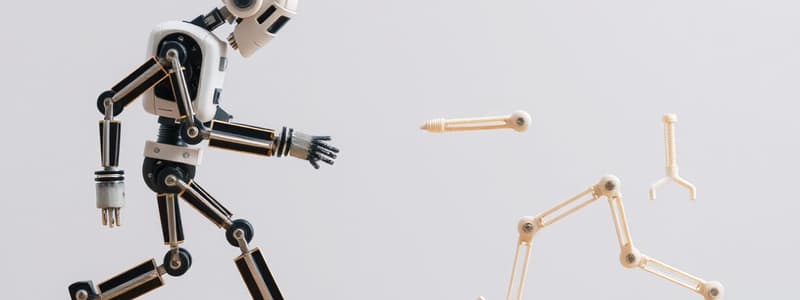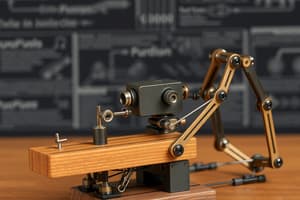Podcast
Questions and Answers
What distinguishes a pushdown automaton from a nondeterministic finite automaton?
What distinguishes a pushdown automaton from a nondeterministic finite automaton?
- It has a larger set of state transitions.
- It can perform arithmetic operations.
- It includes an additional stack component. (correct)
- It recognizes regular languages exclusively.
What is the relationship between pushdown automata and context-free grammars?
What is the relationship between pushdown automata and context-free grammars?
- They are completely unrelated computational models.
- Pushdown automata can only recognize regular languages.
- Context-free grammars can simulate pushdown automata efficiently.
- They are equivalent in power for recognizing context-free languages. (correct)
Which operation is performed to add a symbol to the stack in a pushdown automaton?
Which operation is performed to add a symbol to the stack in a pushdown automaton?
- Popping
- Dropping
- Storing
- Pushing (correct)
Why is a stack beneficial for a pushdown automaton?
Why is a stack beneficial for a pushdown automaton?
What limitation does a finite automaton have in recognizing certain languages?
What limitation does a finite automaton have in recognizing certain languages?
Flashcards are hidden until you start studying
Study Notes
Pushdown Automata Overview
- Pushdown automata (PDA) are an extension of nondeterministic finite automata featuring a stack for additional memory.
- They can recognize non-regular languages due to the stack allowing unbounded storage.
- PDAs are equivalent in computational power to context-free grammars, facilitating two methods for proving language context-freeness.
Components of Pushdown Automata
- Control: Represents states and transition functions within the automaton.
- Input Tape: Contains the input string read by the PDA.
- Stack: Enables the storage and retrieval of symbols, thus allowing the PDA to manipulate data beyond finite memory limits.
Stack Operations
- Pushing: Writing a symbol onto the stack, which moves existing symbols down.
- Popping: Removing the top symbol from the stack, allowing remaining symbols to shift up.
- A stack can theoretically hold an unlimited amount of information, enhancing the PDA's recognition abilities.
Example Language Recognition
- The language {0^n 1^n | n ≥ 0} cannot be recognized by finite automata due to their limited memory.
- A PDA can recognize this language by pushing 0s onto the stack and popping them for each corresponding 1 read.
- Acceptance criteria: Input is accepted if the stack is empty when input ends, rejecting it if the stack is empty while 1s remain or if 0s appear after 1s.
Formal Definition of Pushdown Automata
- A PDA is defined similarly to a finite automaton but incorporates a stack.
- Input and stack alphabets are specified, allowing separate sets of symbols.
- Transition functions are defined based on the current state, next input symbol, and top stack symbol.
Transition Function Characteristics
- Transition functions may operate without reading an input or stack symbol (denoted by ε).
- They specify state changes and stack operations using the notation "a,b → c", indicating that upon reading 'a' from the input, the top stack symbol 'b' is replaced with 'c'.
- State diagrams for PDAs reflect how the automaton transitions while utilizing the stack, analogous to those of finite automata but adapted for stack operations.
Studying That Suits You
Use AI to generate personalized quizzes and flashcards to suit your learning preferences.




